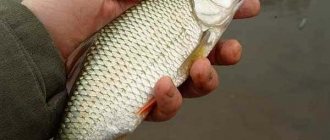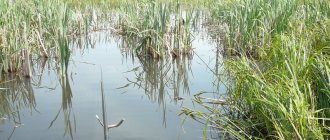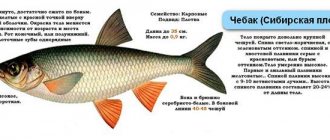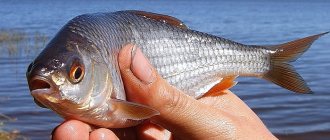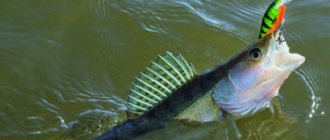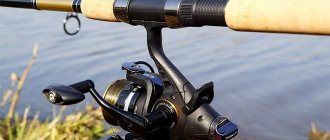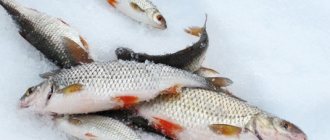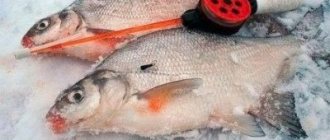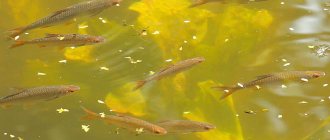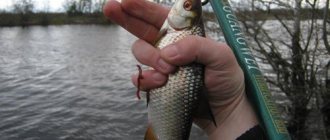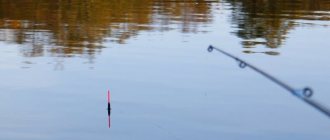Proper equipment of a winter fishing rod for roach and the correct technique for catching this fish are the basis for successful fishing. One of the most common fishing methods is passive, which involves throwing equipment into the hole, after which visual control of the bite is carried out using a float or nod. This article describes exactly this method of fishing. Active fishing with baited jigs, as well as baitless baits, is described in the relevant articles on our website. Equipping a fishing rod for roach in winter can be implemented in various equipment options, depending on the fishing conditions and the preferences of the angler.
How do roaches winter?
The roach does not sleep in winter; it feeds all winter. Depending on the weather, it may be more or less active. At the beginning of winter, it feeds in shallow areas and its summer favorite places, gradually sliding into deeper areas of the reservoir. Then the fish gradually becomes more active, feeds more often and more, and again comes closer to the shore. Read more about the winter habits of roaches here:
Many anglers successfully catch roach in winter using a float and nod throughout this cold season. Others sometimes cannot catch anything other than a couple of small fish. To successfully hunt roach in winter, you need to go through several “stages” and put together some “variables” in the roach bite equation:
- The choice of fishing tactics depends on the time of year and the characteristics of the reservoir.
- Search directly on the reservoir.
- Correct ice feeding system and bait composition.
- Correct equipment and bait.
Shape and size
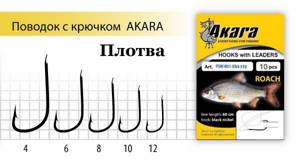
First you need to decide on the most suitable shape of hooks for catching this type of fish. Because even with full confidence in the sharpness of the hook, this does not mean at all that it will be catchy for roach. After all, a working hook is not only one that has a sharp sting. It must also have excellent performance characteristics - the hook must be comfortable, penetrate well and hold the fish.
The shape of the hook for summer fishing should be best suited for vegetable baits: dough, star-shaped pasta and other baits of vegetable origin. Bends in different directions in this case will be unnecessary and perhaps even disturbing. If you plan to fish for wheat, corn or bread crumbs, hooks with short rods will be most suitable. Please note that the beginning of the beard should be closest to the fold. The shorter this part is, the greater the chance that the sting will catch well in the roach’s mouth.
The British even have several special varieties of hooks that they use to catch roach. Unfortunately, in our country it is not so easy to get them, so our compatriots use Kirby and Limerick, as well as Pinel hooks for catching roach, with a bronze coating and bent eyes. They are considered to be the sharpest and strongest.
The optimal size of hooks is selected for each individual case, depending on the size of the fish, as well as the type and size of the bait. And here you need to be especially careful. After all, if the hook size is smaller than required, it may jump out of the fish’s mouth with each hook, and if it is larger, there will be a likelihood of an increase in the number of empty bites.
The number range of roach hooks varies between No. 18 and No. 8. To some extent, No. 10 can be called universal and the most convenient. However, in the case of small fish weighing up to 150 grams. hooks for roach No. 12 or No. 14 are better suited. Well, if you are hunting for large roach and want to avoid small fry bites, you can safely attach hook No. 8. Dung worms are used as bait for this number. When catching fish using maggots or bloodworms, hooks No. 18 are suitable, and hooks No. 10 and No. 12 are well suited for barley grains and corn.
In principle, choosing the size of the hook is not difficult. But there are times when the number needs to be adjusted during the fishing process. Therefore, when going for roach, it is better to have hooks of large and small sizes in your arsenal.
Catching roach with a winter fishing rod - tactics and searching for fish
I hope you have read the general article on winter roach linked at the beginning of this post. From it you will understand at what time and in what places you need to look for this fish in winter. Let's assume that we have decided on the reservoir, time and all other factors, and decided to fish passively using a float (or nod).
It is important to understand that in order to find roach sites on a body of water, especially a large one, you should actively search for it. All tactics for catching this fish in winter are based on this. It's good if this place is known in advance. You can join the fishing town that grew up on the ice - it’s not just that they all sit in one place. If you don’t like noisy companies, then move away from the crowd of fishermen at least 500 meters to get to another feeding area, so that the presence of tens and hundreds of kilograms of bait under fishing tents does not spoil your tactics.
You can successfully use under-ice fishing cameras for searching. Provided there is good visibility under water, exploration using this device can be carried out much faster than with a fishing rod.

Places to look
What bait to use for catching roach
Since I very often catch roach in the current, on the Don River, I use a special composition of bait, which has proven itself in more than one fishing trip.
3 ways to improve your fish bite!
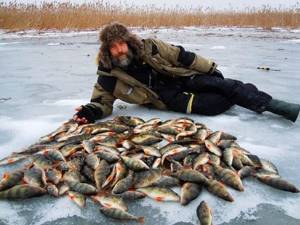
Over 15 years of active fishing, I have found many ways to improve the bite, and here are the most effective:
1. Bite activator . This pheromone additive attracts fish most strongly in cold and warm water. The Fish Hungry bite activator has proven itself to be excellent - Read more…
2. Tackle with increased sensitivity . You should first familiarize yourself with the features of using a particular type.
3. Pheromone baits . They attract the attention of fish, stimulate hunger and cause a schooling reflex, which allows you to collect a lot of fish in one place.
You can get the rest of the secrets of successful fishing for free by reading my other materials on the site.
3 ways to improve your fish bite!
Over 15 years of active fishing, I have found many ways to improve the bite, and here are the most effective:
1. Bite activator . This pheromone additive attracts fish most strongly in cold and warm water. The Fish Hungry bite activator has proven itself to be excellent - Read more…
2. Tackle with increased sensitivity . You should first familiarize yourself with the features of using a particular type.
3. Pheromone baits . They attract the attention of fish, stimulate hunger and cause a schooling reflex, which allows you to collect a lot of fish in one place.
You can get the rest of the secrets of successful fishing for free by reading my other materials on the site.
The composition includes the following ingredients:
— Marcel bait mixture; - some breadcrumbs; — soil; - flavoring, also Marseille; - and about 100 grams of live bait (bloodworms or maggots).

The bait should be mixed directly on the pond, first mix the soil and the bait mixture, then sift the resulting consistency through a sieve, separating the bait from the lumps. Gradually add water and live bait. We add flavoring last, I use liquid, it is most effective. The bait should not be very dense and not very loose. Try to find a middle ground, then the number of trophies will increase!
You need to remember one important detail : you shouldn’t overdo it with the attractant, otherwise the result will be the opposite. Instead of attracting fish, we scare them away and then our fishing will end. After the bait is mixed, we begin to feed the point. We make 3-6 casts of the feeder, then let the point rest for about ten minutes, and only then we start fishing. During the fishing process, the bait can be reduced in volume, because no one wants to overfeed the fish either. With this, we’ll finish our conversation about bait and move on to baits.
Finding a cool place
A winter float rod for roach can be effectively used in combination with gear for active fishing with a jig.
- After determining the initial location, you need to drill 6-10 holes at a distance of 10-15 meters from each other. Closer is not recommended.
- Spot feeding is one of the “golden” rules for roach.
- The second rule is that you cannot feed too much and only once. You need to feed little by little and at intervals. For the first exploration holes, it is enough to drop one ball of bait into them, the size of a walnut.
- Naturally, at a depth of more than 3 meters or in a current, you need to use a dump truck so that the food reaches the bottom exactly under the hole.
- After feeding, we check the holes with a jig, or with a float - but this takes longer. It is important to understand here that at the beginning and end of winter there is no point in sitting in one place for a long time, and in the dead of winter you need to wait at least an hour.
- If there are no bites anywhere, we move further according to the same pattern until we find fish. When checking the holes, you need to change jigs, baits, methods of play and fishing horizon - the fish is not always at the bottom.
When cool places have been found, you can already settle down here thoroughly - set up a tent, drill several holes nearby, feed them well (one fist-sized ball or a full dump truck). We install our gear in these holes. At the same time, in one of the holes you can, for example, try fishing with a reelless bait.
If there is a bite, do not forget to periodically feed the holes (every 10-15 minutes), just a little bit, a pinch. This is necessary to maintain the interest of the roach by forming a feeding column. This fish must not only be attracted to the feeding spot, but also kept under the hole for a long time.
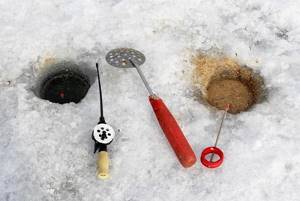
Night roach fishing
Night fishing for roach from ice is quite common. This type of fishing is more often practiced on large lakes, reservoirs and large rivers. For such fishing, you need a winter fishing tent, preferably with a heat exchanger, which will allow you to fish in the most severe frost. The fishing tactic in this case is to sit on bait. Accordingly, the place needs to be found in the evening, so as not to wander around the reservoir searching in the dark.
Catching roach in winter at night in some reservoirs is even more effective than during the day. For fishing, regular winter float gear is used. At night, jigs with phosphor heads can perform well. Such baits are used independently; you can also equip them with a pendant above the main jig. There are no other differences between day and night gear. The feeding tactics are the same as during daylight hours. Here it is more important to ensure your personal comfort in order to enjoy fishing, and not to fight the cold.

Fishing methods and gear
The gear for catching roach in the deep winter is the same as in other periods of ice fishing. The equipment required is thinner, and jigs or baits are small.
- Stationary fishing with fishing rods with a float or nod,
- Classic jig (for playing with bloodworms),
- Mothless,
- Sub-ice bottom gear for currents.
In the dead of winter, roach tackle can play a decisive role. The slightest nuance can make or break a fishing trip. You need to be prepared to constantly experiment with equipment options. As already mentioned, in the dead of winter, the equipment of fishing rods for catching roach requires a thin, elegant one. However, in large reservoirs or on currents, it is not necessary to thin the gear too much. Some anglers fish using rigs with 0.14 mm line. If such a tackle does not bite, the first thing is to put a thin fishing line. Usually it is 0.08-0.12 mm. Fishing for roach in the middle of nowhere can vary even by hour. Now he takes the jig from the bottom, in an hour - on the suspension. Therefore, stopping the bite is not a reason to stop fishing. This is a signal to experiment with jigs, pendants or leash lengths.
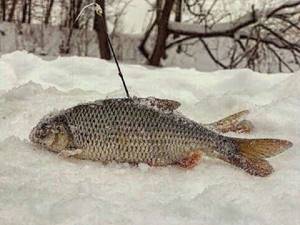
Stationary fishing rods
A classic of the genre is stand-up fishing with a float or nod. After identifying catch points, the angler is placed with several tackles on the working holes. You always need to be prepared for transitions. The cessation of biting at one point does not mean that the roach does not feed in other places. Perhaps a flock of soregs was scared away from the point by perch or pike. Any designs of fishing rods are used - fillies, balalaikas, fishing rods with a handle and reel, homemade ones. What is important here is the equipment itself. The usual installation is a jig at the end of the fishing line. For float fishing for roach in the dead of winter, it is always recommended to equip your fishing rod with two hooks.
One hook should lie on the bottom (mormyshka), the other should be located higher on a pendant 5-6 cm long, 15-30 cm from the bottom. The roach takes it from the bottom, then onto the pendant. In some reservoirs, plastic jigs or regular jigs, but with a drop of luminous varnish, work well. In the dead of winter, float fishing for roach requires fine tuning of the gear so that the equipment compensates for its weight when biting on the rise (with a jig). Bites at this time are often gentle and barely noticeable. It’s better to hook at the slightest suspicion of a bite. When you take the bottom hook or jig, the float usually floats, but when suspended, it sinks or twitches. During periods of capriciousness, the bite can be expressed in weak twitching of the float. Learn more about the correct equipment for winter float gear.
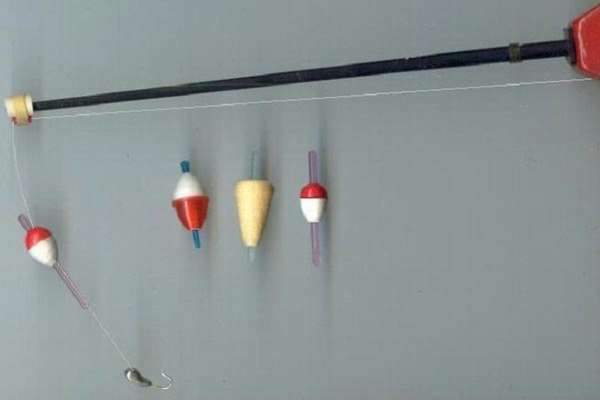
The suspension is formed by any knot in which the lead on the leash is directed to the tip of the fishing rod (so as not to get confused with the main fishing line. The simplest is a figure eight. The necessary ends of the resulting spider are left, the excess is cut off. In some cases, the jig does not work - the fish immediately spits it out when biting Then at the bottom you should use a regular small-sized hook and a grappling pellet.
Many anglers do not use floats, but fish with a nod. The advantage of such equipment is the ability to raise the equipment above the bottom and fish in the thick water, which is especially important for roach that loves to walk up and down. This type of tackle for passive fish can also be equipped with a hook and a hook. The most sensitive working position for a jigless rig is that the hook is on the bottom, and the catch does not lie above it. To do this, after the sinker has fallen to the bottom, we tighten the line a little, but so that the hook remains lying. This option should also be included in experiments with equipment during periods of capricious biting. An article about winter rigging of fishing rods for roach.
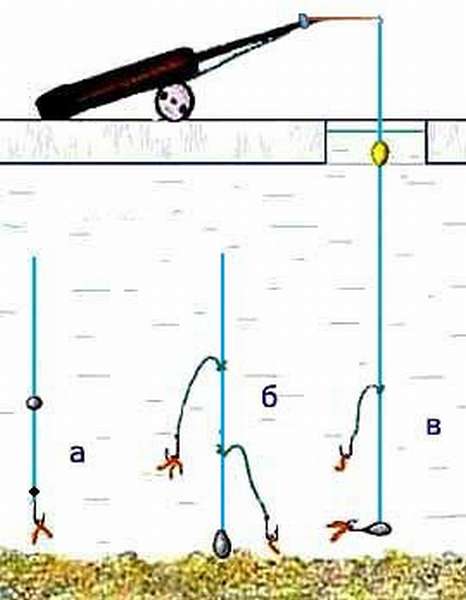
Attachment jig
For winter roach, it is better not to use game fishing in its pure form, but a universal option - with periodic checking of the bite on the stand. When fishing for roach in the dead of winter, the silver sometimes prefers to take a game, at other times - a stationary bait. Therefore, it is advisable to use nodding tackle for jig fishing for roach, also checking that the bait is left on the bottom in the riser. It can be played with or placed motionless. At this time you need to use the smallest jigs, 0.1-0.4 grams, black or light colors. Which one exactly is also a matter of experiment. For deep fishing you will need small, heavy tungsten jigs. The nod is adjusted to the weight of the bait. For roach, some kind of middle option is required - between a short, high-frequency perch and a long bream. Nowadays, nods made of lavsan, astralon or clock spring are used. Only a few anglers remain faithful to boar bristles or horsehair. Read more about jigs and fishing rod equipment.
Playing in the wilderness requires smooth, slow play. Roaches especially love the slow, seemingly natural fall of the bait. When fishing, the first thing you need to determine is what the fish likes most today - a smooth descent, swarming at the bottom, a stationary bait (at the bottom or above it).
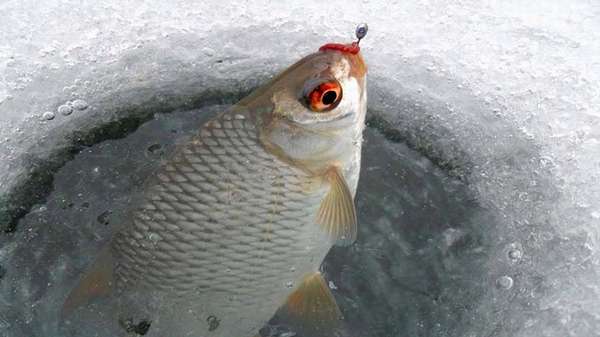
Possible wiring options:
- Slow descent to the bottom, smoothly or with twitching, from a height of about 70 cm.
- Tapping on the bottom, lifting 5 cm. Pause at the top point or at the bottom.
- Regular jig retrieves for lifting, only slower and smoother.
The sharp movements of the jig in the dead of winter will rather scare away the roach, rather than attract it. Pauses at this time should be made long, up to several minutes when the bait is positioned on the bottom. Experimenting with the jigs themselves is also important. Any small pellets, droplets, bugs, oatmeal, as well as small rewinders are suitable. Read more about jigs in the middle of nowhere for roach.
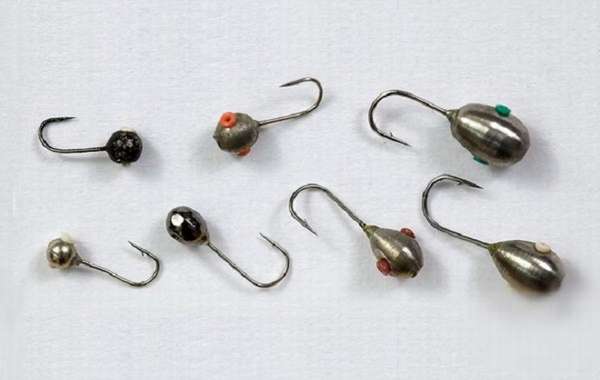
Mothless
The basis of reelless fishing is to arouse curiosity in the fish, not food interest. In harsh wilderness conditions, this roach approach may not work. The basis of windless wiring is high-frequency oscillations. The best time for mothless moths is the beginning and end of winter. In January and February it is easier to catch roach with a jig. However, ardent fans of baitless fish are not left without a catch at this time. The main emphasis is on finding active fish. You should actively use bait and often change the place (or still put a bloodworm on the hook).
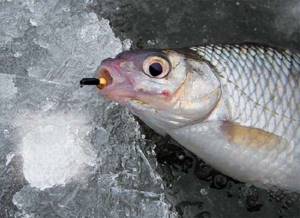
The overall pace of the game is reduced, and for many reelless jigs such a slowdown is fatal. Therefore, in the middle of winter you need to use small jigs with a weighted upper part (Uralkas, goats, nymphs), which nod even when playing slowly. Or nail balls, allowing slow wiring and relatively long pauses. The use of devils also gives good results. Let us repeat, the basis of tactics in this case is not meditation over one hole in empty attempts to seduce a passive roach, but an active search for feeding fish. When handled correctly, a baitless bait brings a catch no worse than a baited jig. An article about winter fishing with baitless jigs.
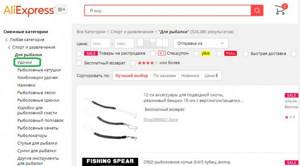
On the current
On rivers, sensitive equipment for still water does not work in the current. Therefore, special installations are required. For light drafts, regular fishing rods with a larger float and a heavy sinker that can withstand the current are suitable. In such conditions, it is more advisable to use fishing rods with a nod. The installation is equipped with a blind sinker at the end of 5-15 grams and retractable leads. The same tackle is convenient to use at great depths of reservoirs for tempo fishing in conditions of good bite. The equipment is simply heavier and quickly reaches the desired horizon. On strong flows of large rivers, winter donkeys are used - slides, slopes, etc. In such conditions, the fish are not so shy; the equipment allows the use of thicker lines. Winter fishing for roach on the current.
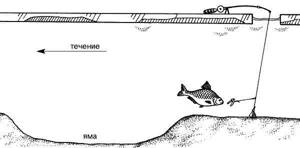
Winter float rod for roach
Let's look at how to make a winter fishing rod with a float for roach. On the water bodies of the Moscow region frequented by fishermen, you will need the thinnest and most accurate tackle possible. The rigging of a winter fishing rod for chebak in Siberia or the Urals can be coarser, especially on wild rivers and lakes. To catch large rams on the Tsimlyansk Reservoir, I sometimes use a 0.2 fishing line, if it takes such a line - it’s easier and faster to work with the gear than carefully taking out a spider line every time. It’s most convenient to have several gear configured for different conditions in your fishing box at once, so that when you determine what you need, you can quickly use it, and not waste precious time on dressing.
Fishing rod
Equipping a winter fishing rod for roach begins with choosing a fishing rod. This is the most undemanding part of the equipment. The main thing is that the fisherman likes it. The fishing rod performs the function of storing equipment. It is also needed for hooking.
Of course, you can tie the float tackle to a stick with reels, but using a winter fishing rod is much more convenient, and they are cheap and accessible. You can make a winter float fishing rod for roach or other fish with your own hands from various materials. A variety of fillies, open and closed balalaikas, ordinary standard winter fishing rods with a handle - the choice is up to the angler.
To fish with a riser, the fishing rod must be on legs, this is especially important when mounting with a nod, since the tackle must be installed in the exact position above the hole. If there are no legs, then instead of them you can use ordinary clothespins, as well as any homemade solutions. The rod of the fishing rod must have a certain flexibility for more convenient hooking. If you plan to use your tackle only with a float, then you don’t have to install the nod at all. The fishing line is then secured to the tip of the whip with a tube.

Types of fishing rods
fishing line
The line is what matters.
- The diameter of the fishing line for a winter fishing rod for roach can vary from about 0.08 to 0.2 mm.
- Thicker rigging is hardly advisable even for the largest ram.
- In reservoirs pressed by fishermen, where there are few fish or they are very cautious, you need to use a 0.08-0.1 fishing line.
- On reservoirs this will already be a monofilament of 0.12-0.14, and even 0.16 mm.
It all depends on your fishing conditions. You need to reel in plenty of fishing line on the fishing rod, because you don’t know at what depth you will have to fish. But for most cases, especially if you are making a fishing rod specifically for roach, 10-15 meters will be enough. Winter fluorocarbon is installed as a fishing line on the fishing rod, which can be taken somewhat thicker, due to its invisibility in the water. Recently, siglone and nanofil have been gaining popularity. It is more advisable to use these types of fishing lines for making leashes, using ordinary monofilament as the main one.
Note! Fluorocarbon, siglone and nanofil are tied with special knots during installation, since they greatly lose strength on ordinary loops or figure eights.
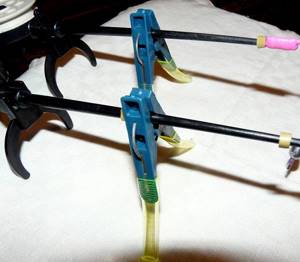
Clothespins for legs
Floats
Equipping a winter fishing rod for roach for fishing in still water requires the presence of a float. There are a huge variety of them, there are no special requirements. You can set up a winter fishing rod for roach in different ways, depending on whether the sinker (or jig) will be located at the bottom, or whether the equipment should hang in the water column.
The fishing rod needs to be tuned carefully. For floating rigs, we select the sinker so that the float holds the rig. In a sinking one, on the contrary, the float is drowned by the weight of the sinker. In severe frost, even if you need to fish above the bottom, you need to use sinking equipment so that the float does not freeze into the ice. And on the desired fishing horizon, a branch leash is simply placed. There are many options, which one will work well in a pond depends on the fishing conditions and the preferences of the fish. It is better to do the loading and rigging of the fishing rod at home in advance, conducting tests in a jar of water, so that you arrive at the pond already fully equipped.

Winter floats
Hooks
When installing a winter fishing rod for catching roach, you need to use good and sharp small hooks that will not prevent it from completely swallowing the bait. Roaches often respond well to red or light-colored hooks, but not always. It is better not to use the smallest swallows (throats) so that large fish do not fall off when fishing.
Jigs
The equipment of a winter float fishing rod may include a jig instead of a sinker and a hook. You need to understand that the weight of the bait must be matched to the float. For roach you need to use small jigs. This type of tackle allows you to additionally attract fish by tapping the bottom from time to time.
Installation of equipment
Each of the above-described gear is characterized by its own equipment, consisting of a main line, a float, the location and type of sinkers and a hook that are correctly selected according to the diameter.
Fly tackle
- Rod – 4-5 m.
- The main line is 0.18-0.22 mm.
- Spindle-shaped float with a long antenna and a weight of 2-3 g.
- Leash made of fishing line - 0.12-0.14 mm.
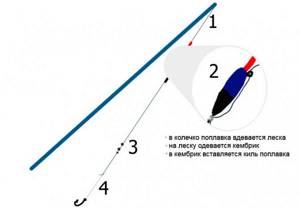
Bolognese fishing rod
- Rod – 5-6 m.
- The main line is 0.2-0.22 mm.
- A float with a spherical or teardrop-shaped body and a long antenna.
- Leash with a cross section of 0.12-0.14 mm.

Match tackle
- Rod – 5 m.
- The main line is a special sinking line 0.16-0.18 mm.
- A float for match fishing with an olive-shaped body, a long antenna and a bright nozzle.
- Leash with a cross section of 0.10-0.12 mm.
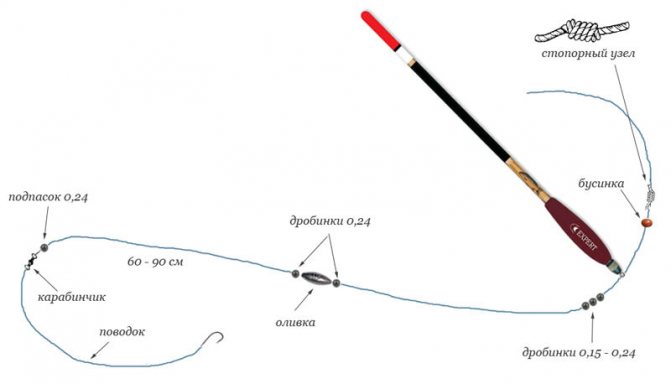
Match equipment
Plug fishing rod
- Rod – 13-15 m.
- The main line is 0.1-0.12 mm.
- Leash – 0.06-0.08 mm.
- The float is spindle-shaped with a load of 0.3-0.5 grams.
Options for installing winter float rigs for roach
Installation features depend on fishing conditions. There are a huge number of options for rigging winter fishing rods for roach; every angler can experiment in search of the most successful gear arrangement.
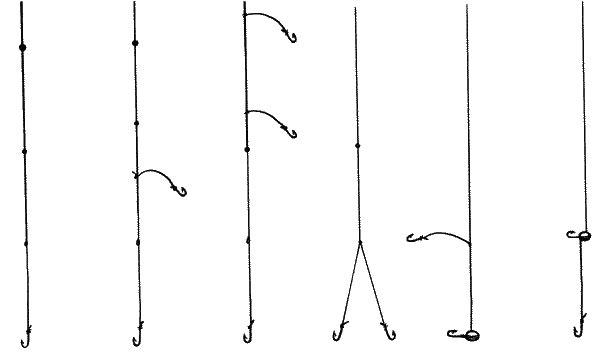
Equipment options
The most sensitive option for equipping a winter fishing rod for roach
The universal equipment is a small jig at the end and a sliding lead (after all, it is not immediately known at which horizon the bite is better). Instead of a jig, of course, you can tie a hook and shot 3-4 centimeters above it. All together should sink the float.
With this setting of a winter fishing rod for roach, there is a retractable leash on the rig, which you can move and experiment with the fishing horizon. Very often the roach takes it on it, and not from the bottom. Such equipment has more than once saved me at the Tsimlyansk Reservoir from pressure from finger-sized crucians, which take from the bottom and simply do not give life when they approach. With such an attack, I simply stopped placing the bloodworm on the bottom hook, thus fighting off the bites of micro crucian carp. And he continued to drag the roach to the upper outlet, 30 centimeters from the bottom.
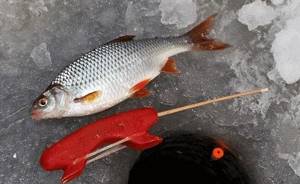
There is one subtlety here. At great depths, a light shot (and, accordingly, the smallest float) is inconvenient, since the equipment sinks very slowly. In this case, you can equip the fishing rod with a larger float and, accordingly, a heavy shot, but of such a borderline weight that it alone could not sink the float, but when adding a small pod near the hook, it would drown it.
If the grain sinks it on its own, then when installing the tackle it will fall to the bottom, and gentle bites will not be visible. Thus, a sinker with a pad (small jig) sinks the float, but without a pad it does not. This achieves the situation we need - a light bait lies on the bottom, without preventing the roach from taking the bait (since it is very light), the main sinker hangs in the water, the float is under water at the level set by the fisherman (2-3 cm below the surface) and does not freeze into the formed a crust of ice in the hole. When bitten, the float usually floats up, but sometimes the fish grabs it boldly, and the float goes straight down.
A common option is a blind sinker at the end and two lead leads. The length of the lower one should be such that the bait lies on the bottom. Instead of hooks, sometimes plastic floating jigs or foam balls directly on the hook work well.
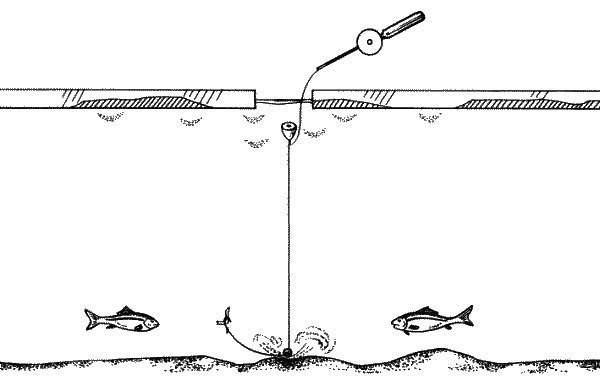
Equipment option with an under-hitch at the bottom
Feeder gear for roach fishing
Roach prefers places with slow and medium currents. Therefore, when fishing for it, light and medium rods with a test weight of 40 to 100 grams and a length of 3.6 to 3.9 meters are most often used. There are, of course, exceptions when, with a strong current, a feeder weighing 100 grams or more is carried away by the current. In this case, use heavy-duty rods with a weight of up to 150 grams.
A few words about the structure of a feeder rod for catching roach. Since roach cannot be classified as a large fish, even if you want to, you can use a delicate rod for fishing it, which will “carefully” fish out this fish. A parabolic type rod is best suited for roach. It is also called a slow feeder. With its help, hooks are smoother and less traumatic for the fish.
If we describe in simple words what kind of rod is parabolic, then when shaken it bends like a noodle along its entire length. Take fast, medium and slow action rods from any fishing store and shake each one a little. You will notice that fast rods bend by a maximum of a third, medium ones by half, and slow ones, as mentioned above, bend like a whip. One of these rods is the Mikado ULTRAVIOLET Light Feeder 360 with 90 gram dog test. With this you can comfortably fish on medium and small rivers. Casting over distances of 50-60 meters can be done without problems. At the same time, the accuracy is very good.
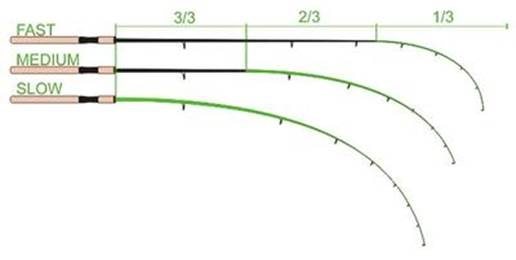
Tips are included with the feeder rod. For fishing for roach, it is better to use the most sensitive tips. We also make allowances for the wind. The stronger the wind, the closer to the water we place the rod.
Each tip must have a marking that determines the stiffness of the tip. The higher the number, the stiffer the whip. If there are no markings, then the rigidity can be easily checked by touch with your fingers. It is enough to take each tip and bend it a little to understand which one is softer and which one is harder. For roach, it is better to place a soft tip in calm or little windy weather. With an average gust of wind, we set a stiffer tip.
A reel on a feeder rod for catching roach is used with a spool capacity of 3000 to 4000. We make sure that the weight of the feeder is correlated with the weight of the rod. The lighter the rod, the lighter the reel should be. For roach, as for any small-sized fish, balanced and harmonious tackle is very important. The clutch can be either front or rear. For roach fishing, this is not the most important element. We wind a fishing line with a diameter of 0.2-0.25 m onto the reel with a slight stretch. The color of the line can be light, brown or black. If we are fishing on a steep edge, then it is advisable to place a feeder between the main line and the leash. The leash is used in different lengths. It is better to have a supply of leashes of different lengths. In slow currents, leashes 30-40 cm long are suitable, in medium flows - 60-80, and in fast currents, leashes of more than a meter are used.
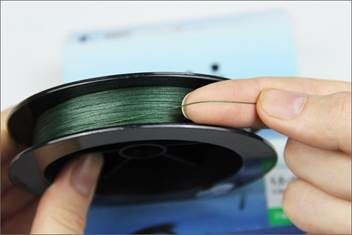
You can also put a braid on the reel. It is desirable that it be round in cross-section and covered with a special layer that protects the line from damage and wear. The smooth wattle fence practically does not rub the rings and does not wear them out. Pay attention to this moment. When using a fence, it is better to have rings coated with a special varnish or paint that protects them from chafing with the cord.
Catching roach with a winter fishing rod with a nod
The simplest winter fishing rod rig for roach is one jig. In principle, in this option you can use a fishing rod for active fishing with a jig, it’s just that in this case it is installed on the ice. For convenience, the fishing rod should have legs. A fishing rod for nod fishing must have a reel, otherwise it will be difficult to set the correct position - a half-bent nod, a jig on the bottom. This kind of tackle can also be raised above the bottom to fish the upper layers. It is advisable to set a sensitive nod to the roach, since sometimes the bites are weak and unnoticeable, especially in the dead of winter.
A winter roach fishing rod with a nod can also be equipped with a regular sinker with a hook, and a blind weight at the end with retractable leads. Installation for catching roach on a winter fishing rod with a nod and a jig allows you to periodically play with the bait, which very often brings good results.
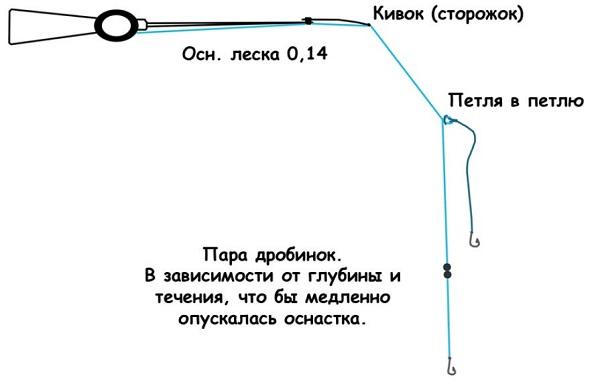
Fishing rod rig with nod and retractable leash
Winter fishing rod for current
A roach rig for a winter float rod in strong currents requires a heavy sinker and special baiting tactics. In a current of medium strength, to catch roach, you can use the equipment of a winter float rod with a retractable leash; the float should be such that it is not pulled under the ice by the current. Read more about catching this fish on the current in winter in the article:
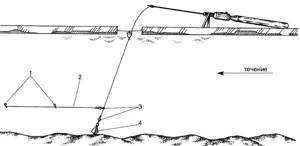
Diagram of a fishing rod with a float for the current
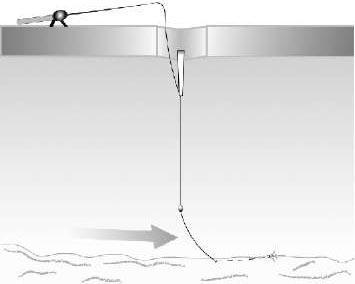
Low current rig option
Nozzles
The main bait is, of course, bloodworms. And here, too, it is important to choose an option that the fish will like. A roach can take one larva, but not two or three, and vice versa. Sometimes she reacts to a sandwich of bloodworms and maggots. In addition to bloodworms, there are a number of baits that can be tested on a pond - they show very good results.
Among the many options, we will indicate only those that actually work on roach:
- Cow udder painted red with food coloring (piece)
- Maggot
- Chernobyl (burdock moth larva)
- Dough (via syringe)
- Semolina powder (via syringe)
- Mormysh
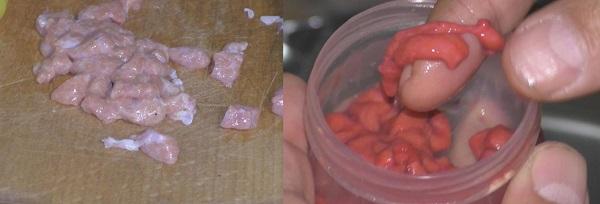
Udder
The udder deserves special attention. Roaches are very attracted to the smell of this bait. Few people use it because it is difficult to get. It cannot be found in department stores, but can be obtained at the market or slaughterhouse. A small piece of 300 grams will be enough for the whole winter if you cut it into small pieces the size of a matchbox (for each fishing trip) and put it in bags and hide it in the freezer.
When fishing, we cut off a pea-sized piece with a knife and place it on a hook. This bait holds well on the hook, even with a very active bite, sometimes the bait does not change even once during the entire fishing trip. Once a year it’s worth the trouble and finding it, thus providing yourself with excellent bait for the whole season.
Another excellent and rarely used bait is blackfish. You can get it in the fall in dry branches of Chernobyl plant (burdock). The bushes must be broken up and stored somewhere in the yard, and the larvae must be removed before fishing. It will not be possible to get it out immediately and store it all winter - the larvae will die. And they will feel great in the branches even in severe frost. To catch roach, you can try using various special dips, pheromones and activators. Sometimes it helps, sometimes it doesn't.
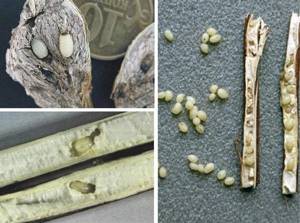
Burdock moth larvae
Groundbaits
Catching roach and rams in winter with a float involves the active use of bait. As we have already said, it is important not to overfeed the roach; it is necessary to feed it little by little, point by point and constantly add a little to maintain the feed column. More details about this, as well as about the composition and production of the best bait for roaches in winter, are described in this article:
https://podlednik.ru/nazhivki-i-podkormki/prikormka-dlya-plotvy-zimoj
Proper use of bait is the most important factor for successful winter fishing for this fish. Therefore, when preparing for fishing, pay maximum attention to this issue.
Subscribe to the channel:
My YouTube channel RYBAFAN on fishing:
We're OK
How to catch roach on a feeder
Before we start fishing, we must feed the point, make sure that the working gear is in order, and only then start fishing. It is very important to maintain distance when casting. This can be done by securing the fishing line in the reel clip, or by measuring the length along the turns of the reel. An indispensable fishing companion will be a comfortable platform on which you can sit and place your fishing rods. The feeder must be positioned in such a way that the tip is practically in the water, the line is naturally always in a taut state, otherwise the effect will be bad.
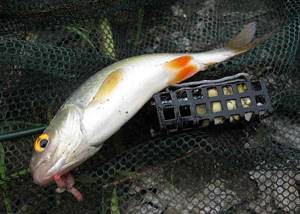
When the pecking stops, you just need to change the point or experiment with the bait, perhaps you need to add more bait to it. The cessation of bites is sometimes due to the fact that the roach leaves the feeding point to another place. The only correct solution in this situation would be to increase the casting range and feed another point. Only then will we regain her interest, thereby resuming the bites.
Fishing out a roach is not particularly difficult, although it stubbornly resists. Breakages practically never happen, and if they do, it is only through the fault of the fisherman. I think this is where we should end. In this article I tried to describe catching roach on a feeder. Here you learned everything you need to know about fishing for rafts on a feeder, and about roach in general. Thank you.
